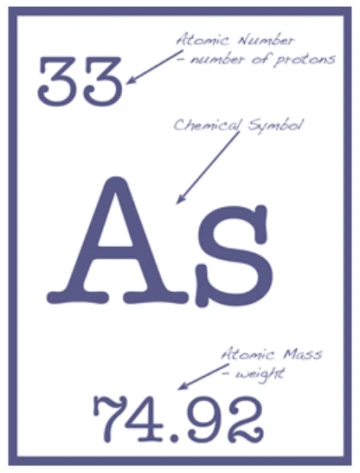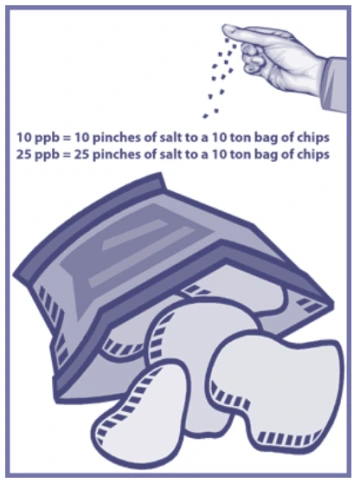
Figure 1. Chemical abbreviation for arsenic along with its atomic number, and atomic mass.
The chemical abbreviation of arsenic is As (Figure 1). It is a solid substance that is naturally found in the Earth’s crust. It can be incorporated into soil, dust, water, food, and air particles. Arsenic is an element, which is classified as a semi-metal. Its pure form is gray colored and it is usually found in combination with other elements (e.g. gold, silver, lead, and copper). It has no odor or taste.
The presence of arsenic can increase due to human activities such as mining [1] and industrial operations. It can be released into the air and subsequently deposited onto bodies of water and surface soil. In general, arsenic and compounds containing arsenic are very toxic and as a result their use is strictly controlled by health and environmental regulations. There are two different chemical forms: inorganic and organic. Almost all arsenic is found in the inorganic form and it is what we come across in soil, rocks, groundwater, surface water, and industrial waste. Organic arsenic, on the other hand, can be found in pesticides, animals, plants, and fish.
Humans have used arsenic for a very long time. In the past, it was utilized as a fabric dye, beauty treatment, and leather tannin. Common uses of arsenic today are as wood preservatives, agricultural insecticide, cotton defoliants (causes leaves to fall off), as well as in electronic and medicine products. The most current concerns regarding arsenic include natural sources contaminating drinking water and its absorption in some foods (e.g. rice and lettuce) that we may consume.
Either inhaling or ingesting arsenic exposes living organisms to it potential negative affects. The main routes of arsenic exposure in humans are drinking water, dust, and food (Table 1). Inorganic arsenic does not easily penetrate the skin so bathing, laundering, showering, and washing are not concerns when it comes to exposure. Caution should be taken when cooking with water that contains arsenic since it can be absorbed by foods.
| Route of exposure | Exposure |
|---|---|
| Drinking Water |
|
| Dust |
|
| Food |
|
An issue important in some environments, such as Arizona and Sonora, is the presence of naturally occurring inorganic arsenic in the groundwater. In these areas, this is considered a type of water contamination. Water that encounters rock formations can dissolve arsenic and carry it into water supplies. The arsenic containing rock formations dissolves because water changes the chemical composition of the rock. In other words, as water travels by the rock formation, it can take with it minerals, metals, and semi-metals.
Arsenic is classified as a known human carcinogen. The health effects that result from exposure to arsenic compounds varies depending on route, dose, duration, lifestyle, and genetics (Table 2). Exposure to too much arsenic can result in harmful side effects. Most of the arsenic that enters the body is processed quickly and discharge via the urine (a single dose is discharged in the urine within 1-3 days). Those most susceptible to arsenic toxicity are unborn babies and children. In addition, those who are elderly or have poor diets can also be more susceptible to harmful effects.
| Arsemic Exposure | Potential Health Effects |
|---|---|
| Acute | Stomach pain, nausea, vomiting, diarrhea, headache, tired, throat dryness, difficulty urinating, and dizziness |
| Chronic | Skin lesions, skin discoloration, kidney damage, anemia, low blood pressure, headache, weakness, delirium, liver problems, irritation of nose membrane, and cancer of the lungs, skin, and bladder. |
Under United States drinking water law, water from public systems must be tested for arsenic. In the U.S. the maximum contamination level (MCL) for arsenic that is allowed in drinking water as established by the US Environmental Protection Agency (US EPA) is 10 parts per billion (ppb). The MCL is an enforceable drinking water quality standard. It indicates the upper limit of a substance that can be present in public water systems. The US EPA sets this standard by considering how much of the substance may be present without causing adverse human health effects. It is important to highlight that the US EPA only sets these standards for drinking water, and does not regulate bottled water.

In Mexico, the National Water Commission (Comisión Nacional del Agua – CONAGUA) has set 25 ppb as the arsenic limit within drinking water systems. CONAGUA has the authority to enforce this standard while the Federal Legal Office for Environmental Protection (Procuraduría Federal de Protección al Ambiente) must take legal action if there are any infractions. Municipal infrastructure authorities and communal land systems (ejidos) also are involved in managing drinking water systems at a local level.
Reducing arsenic exposure is important in order to decrease the potential health effects. There are several ways that you can decrease exposure. Behavior changes, treatment technologies, cleaning techniques, and consumer choices are some of the primary ways to diminish exposure. Of course, general information on arsenic and awareness of it presence also is very important. If there is a suspicion that there has been an arsenic intoxication, medical doctors can perform tests to find out. They can either look for arsenic in the body or the level of arsenic present. They usually use urine or finger nail samples to preform these tests.
When it comes to drinking water, there are two types of removal technologies (treatment) that are available for at home installation (Table 3). Both adsorption media and reverse osmosis technologies can be installed to clean arsenic from water either before it enter your home (point of entry) or after it enters the home (point of use). If a private well supplies drinking or irrigation water, be sure to test it regularly for different contaminants such as arsenic. This is extremely important in areas with a known presence of arsenic in the rock formations or groundwater.
| Arsenic Removal Technology | Description |
|---|---|
| Adsorption Media | Water that contains arsenic passes through a filter made out of metal (iron, alumina, zirconium, or titanium). |
| Reverse Osmosis | Water that contains arsenic passes through a fine filter (membrane) that does not allow the arsenic to pass through. |
To decrease arsenic exposure in the home, sources must be eliminated. Reduce the amount of dust that travels inside the home as well as the dust particles that may be suspended while cleaning (e.g. dusting and sweeping). One option might be to sweep or dust with a moist broom or cloth. In addition, wash hands frequently. This is especially true of children since they frequently place their hands in their mouths. Children also play with toys that have been on the ground, so make sure to thoroughly wash them after they are done playing with them.
If someone in the household comes into contact with arsenic due to their occupation or an outside activity, take precautions to decrease the introduction of arsenic containing dust or chemical in the home. Take off or change shoes before entering the home. It is also a good idea to shower and change clothes after work to further decrease arsenic exposure.
Outside of the home, arsenic exposure can be decreased or eliminated by reducing the use of arsenic containing pesticides (e.g. look for these chemical names on the label (monosodium methanearsonate and disodium methanearsonate). Residue from these products can eventually make it inside the home or can travel throughout the environment affecting animals and plants. Pressure treated wood contains a preservative that is made with arsenic (chromated copper arsenate). This preservative has been used on wood found in outdoor decks, furniture, and play sets. If you own products made with this type of arsenic treated wood, you should consider eliminating it. ;If you choose to do away with it, make sure that it is disposed of properly and not in your local landfill. Find out where the nearest hazardous waste collection center is located that will accept this lumber by the local calling waste managements services.
Glossary
Adsorption media: water containing a contaminant passes through a filter made out of metal (iron, alumina, zirconium, or titanium) in order to be cleaned.
Arsenic: solid substance that is naturally found in the Earth’s crust.
Carcinogen: ability to cancer causing.
Element: pure substance that cannot be separated into simpler substances by physical or chemical means.
Inorganic: substance that does not contain carbon.
Maximum contamination level: legal standard set by the United States Environmental Protection Agency determining the limit of a substance that is in public water systems.
Mine tailings: materials left over after mining of targeted ore/minerals. It is usually considered waste and uneconomic component consisting of rock, dirt, and water.
Organic: a substance that contains carbon or hydrogen.
Part per billion: value that represents one microgram per liter (liquid) or one microgram per kilogram (solid). Another way of looking at it is 1 part in one billion parts or one drop of ink in a large tanker truck (about 13,000 gallons).
Point of entry: placement of treatment system before water enters the home.
Point of use: placement of treatment system after water enters the home.
Reverse osmosis: water containing a contaminant passes through a fine filter (membrane) that does not allow the contaminant to pass through.
Semi-metal: nonmetallic element that is lusterless and solid and can transfer a certain amount of electricity and heat.
[1] Arsenic is associated with the mining of different metals such as copper, silver, and gold. Usually, it is extracted with the bulk material containing both arsenic and metal or it is found as a mineral such as arsenopyrite.

